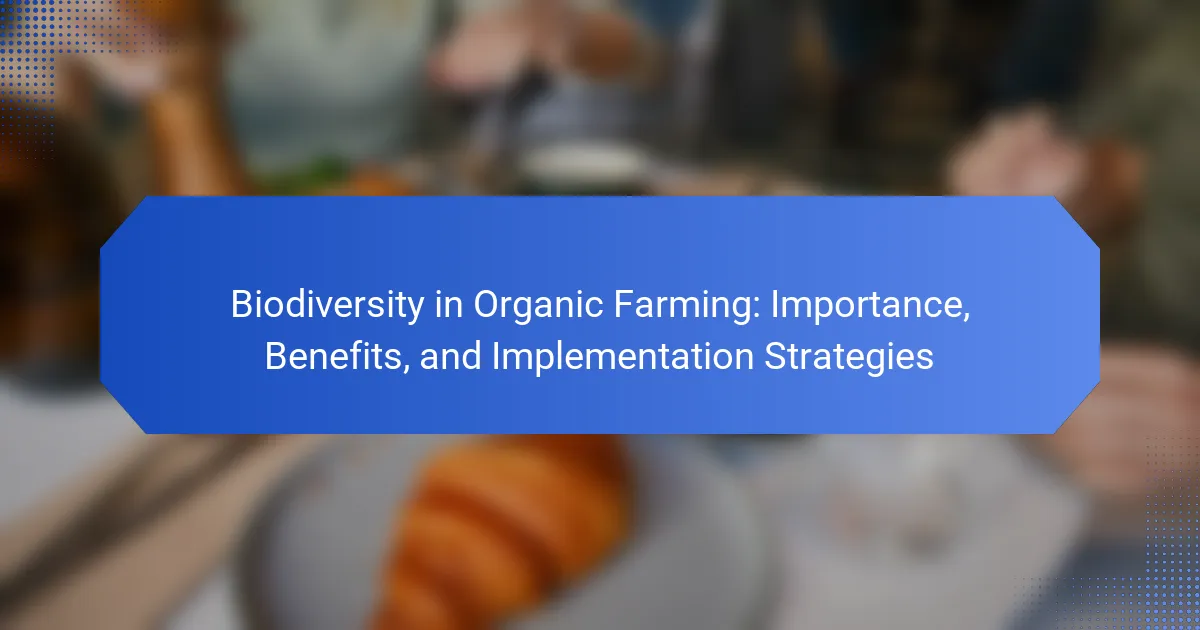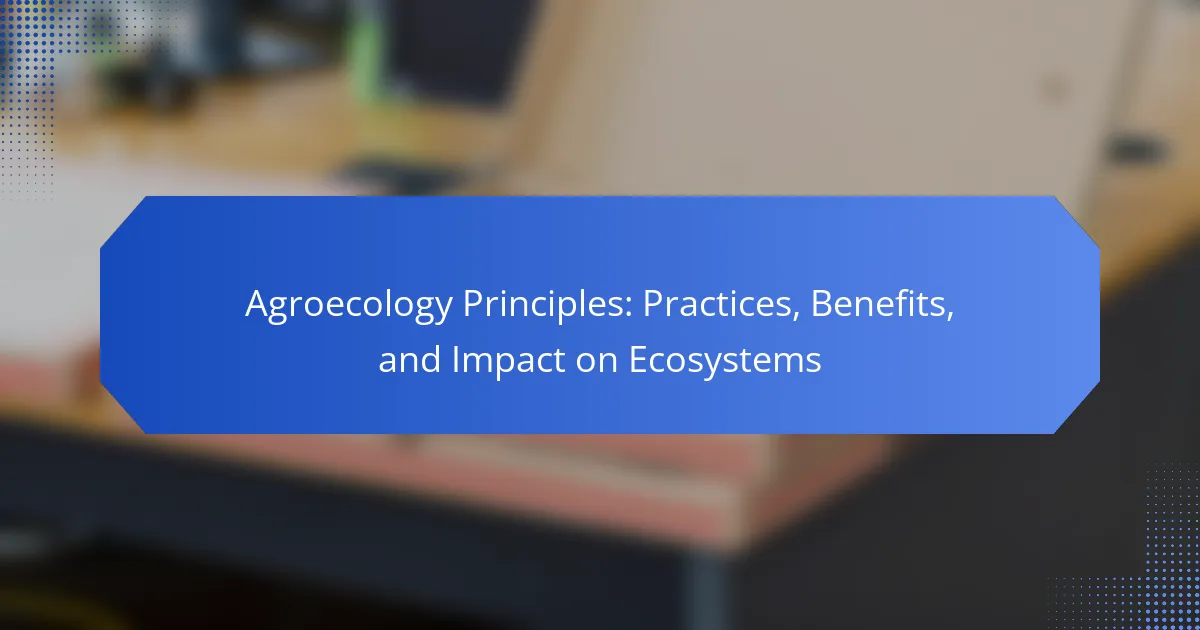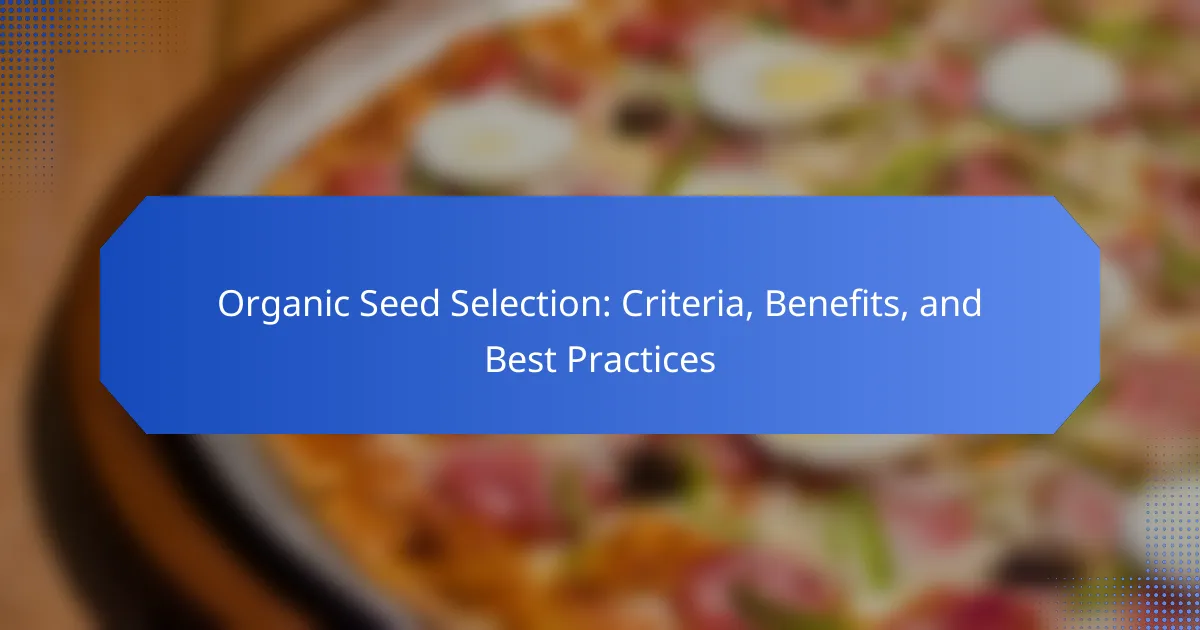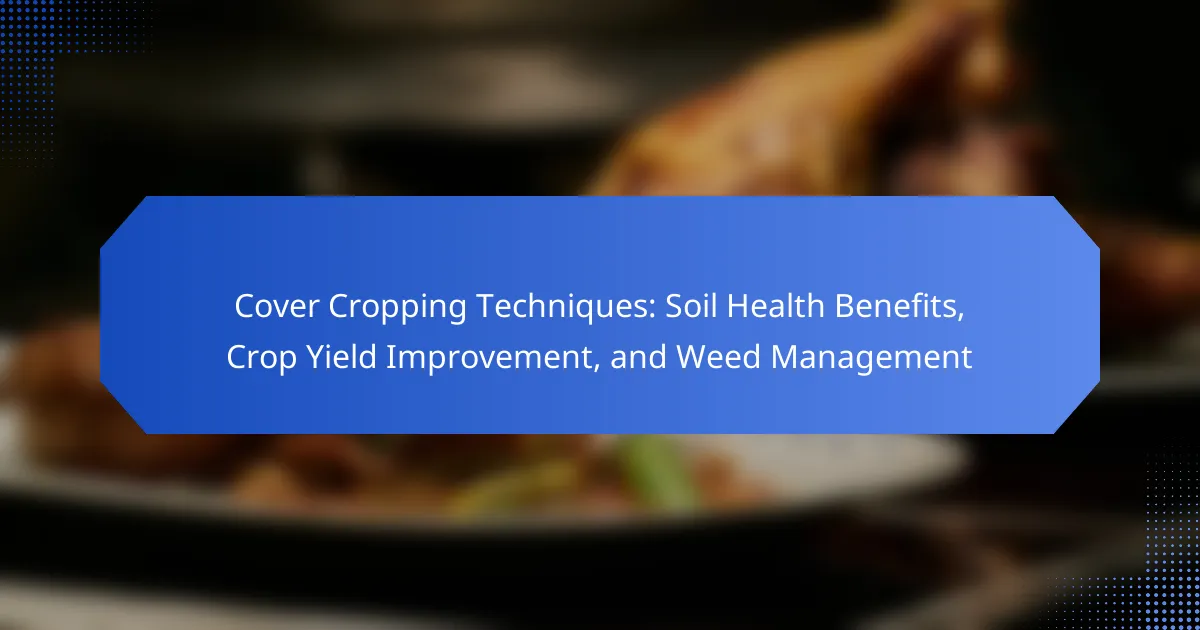Integrated Pest Management (IPM) is a sustainable pest control approach that combines biological control, habitat manipulation, and the use of resistant plant varieties, with chemical methods as a last resort. This strategy significantly reduces pesticide use, enhances crop yields, and minimizes risks to human health and the environment. In organic farming, IPM promotes biodiversity and improves soil health, leading to healthier crops and safer food. Key practices include monitoring pest populations, employing biological control agents, and utilizing cultural methods such as crop rotation. Research supports the effectiveness of IPM in fostering sustainable agricultural practices while maintaining productivity and economic viability.
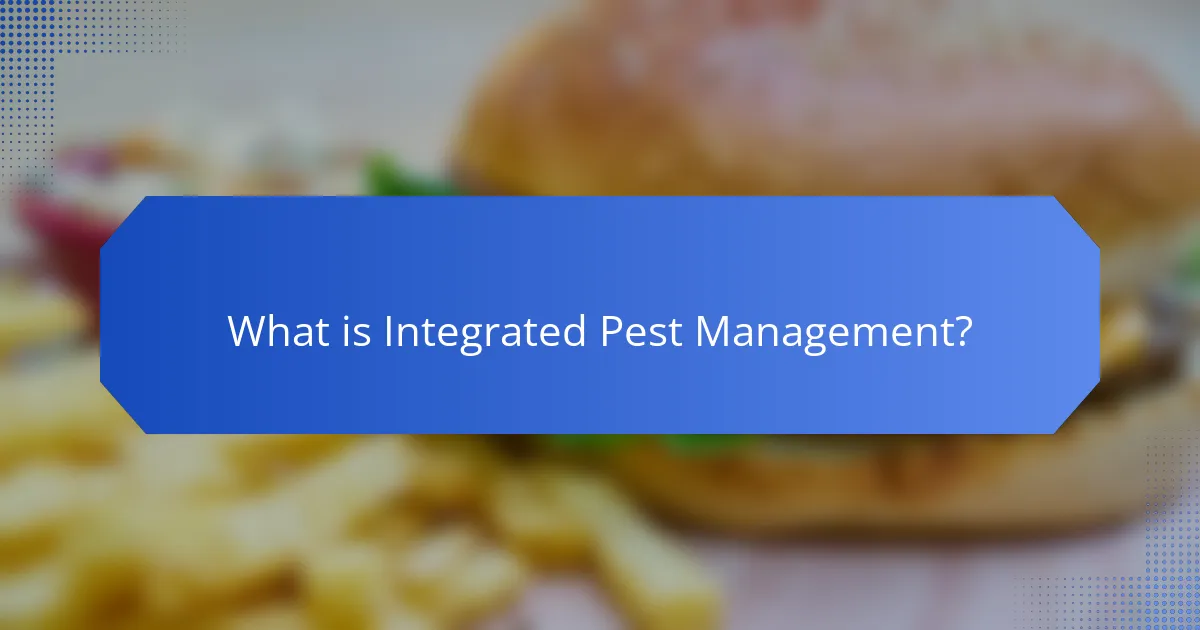
What is Integrated Pest Management?
Integrated Pest Management (IPM) is a sustainable approach to managing pests. It combines various management strategies and practices to control pest populations effectively. IPM emphasizes the use of biological control, habitat manipulation, and resistant plant varieties. Chemical control methods are used as a last resort. This approach minimizes risks to human health and the environment. Research shows that IPM can reduce pesticide use by 50% or more. Studies indicate that IPM can lead to increased crop yields and reduced pest damage.
How does Integrated Pest Management function in agriculture?
Integrated Pest Management (IPM) functions in agriculture by combining various management strategies to control pest populations effectively. It emphasizes the use of biological, cultural, physical, and chemical tools in a sustainable manner. Farmers monitor pest populations to determine when control measures are needed. This monitoring helps reduce unnecessary pesticide applications. IPM prioritizes the use of non-chemical methods first, such as crop rotation and natural predators. Chemical controls are only used when necessary and in a targeted manner. Research shows that IPM can reduce pesticide use by 30-50% while maintaining crop yields. This approach promotes environmental health and reduces the risk of pest resistance.
What are the key principles of Integrated Pest Management?
The key principles of Integrated Pest Management (IPM) include prevention, monitoring, and control. Prevention involves implementing practices that reduce pest establishment, reproduction, and survival. Monitoring refers to regularly checking for pest presence and damage to make informed decisions. Control methods can be cultural, biological, mechanical, or chemical, prioritizing the least harmful options. IPM emphasizes the use of multiple strategies in combination rather than relying on a single method. This holistic approach minimizes risks to human health and the environment while effectively managing pest populations. Research shows that IPM can lead to reduced pesticide use and increased crop yields.
How do these principles differentiate Integrated Pest Management from traditional pest control?
Integrated Pest Management (IPM) differs from traditional pest control by emphasizing a holistic approach to pest management. IPM integrates multiple strategies, including biological control, habitat manipulation, and cultural practices. Traditional pest control often relies heavily on chemical pesticides as the primary solution.
IPM focuses on long-term prevention and ecological balance. It assesses pest populations and environmental conditions before deciding on interventions. Research indicates that IPM can reduce pesticide usage by up to 50% while maintaining crop yields. This approach minimizes risks to human health and the environment.
In contrast, traditional methods may lead to pesticide resistance and environmental degradation. Thus, IPM promotes sustainable practices that enhance biodiversity and soil health.
What are the main components of Integrated Pest Management?
The main components of Integrated Pest Management (IPM) include monitoring, prevention, and control strategies. Monitoring involves regular observation and assessment of pest populations and their impacts. Prevention focuses on practices that reduce pest establishment, reproduction, and survival. Control strategies encompass a variety of methods, including biological, cultural, mechanical, and chemical controls. Each component works together to minimize pest damage while reducing reliance on chemical pesticides. IPM aims for sustainable pest management by integrating these components effectively.
What role do biological control agents play in Integrated Pest Management?
Biological control agents play a critical role in Integrated Pest Management (IPM). They help regulate pest populations naturally. This reduces reliance on chemical pesticides. Biological control agents include natural predators, parasites, and pathogens. These agents target specific pests while minimizing harm to beneficial organisms. For example, ladybugs control aphid populations effectively. Research indicates that using biological control can reduce pest damage by up to 50%. Implementing these agents enhances sustainability in agricultural practices. This aligns with organic farming principles, promoting ecological balance.
How is monitoring and assessment conducted in Integrated Pest Management?
Monitoring and assessment in Integrated Pest Management (IPM) involves systematic observation of pest populations and their impacts. It includes identifying pest species, determining their abundance, and assessing damage levels. Regular field surveys are conducted to collect data on pest presence and population dynamics. Tools such as traps, visual inspections, and scouting techniques are utilized for accurate monitoring. Data gathered helps in making informed decisions about pest control measures. This approach is crucial for evaluating the effectiveness of IPM strategies over time. Research indicates that effective monitoring can reduce pest outbreaks by 50% in agricultural settings.
What strategies are utilized in Integrated Pest Management?
Integrated Pest Management (IPM) utilizes multiple strategies to control pest populations. These strategies include biological control, where natural predators are used to manage pests. Cultural practices, such as crop rotation and sanitation, help prevent pest establishment. Mechanical control involves physical methods like traps or barriers to reduce pest access. Chemical control uses pesticides judiciously, focusing on targeted application. Monitoring and assessment are crucial for determining pest levels and the effectiveness of control measures. Education and outreach programs inform farmers about best practices in IPM. These strategies collectively enhance pest management while minimizing environmental impact.
What cultural practices are part of Integrated Pest Management strategies?
Cultural practices in Integrated Pest Management (IPM) include crop rotation, intercropping, and the use of resistant varieties. Crop rotation disrupts pest life cycles by alternating different crops in the same area. Intercropping involves planting different crops in proximity to reduce pest populations. Resistant varieties are bred to withstand specific pests and diseases. These practices enhance biodiversity and promote ecological balance. Implementing these strategies can lead to reduced chemical pesticide use. Research indicates that cultural practices significantly lower pest incidence in various agricultural systems.
How do physical and mechanical controls contribute to Integrated Pest Management?
Physical and mechanical controls play a crucial role in Integrated Pest Management (IPM). These methods include barriers, traps, and manual removal of pests. Barriers prevent pests from accessing crops, reducing infestation rates. Traps help monitor pest populations and capture them, leading to lower numbers. Manual removal can directly decrease pest populations. These controls are environmentally friendly and reduce reliance on chemical pesticides. Studies show that IPM practices, including physical and mechanical controls, can lead to significant reductions in pest damage while promoting sustainable agriculture.
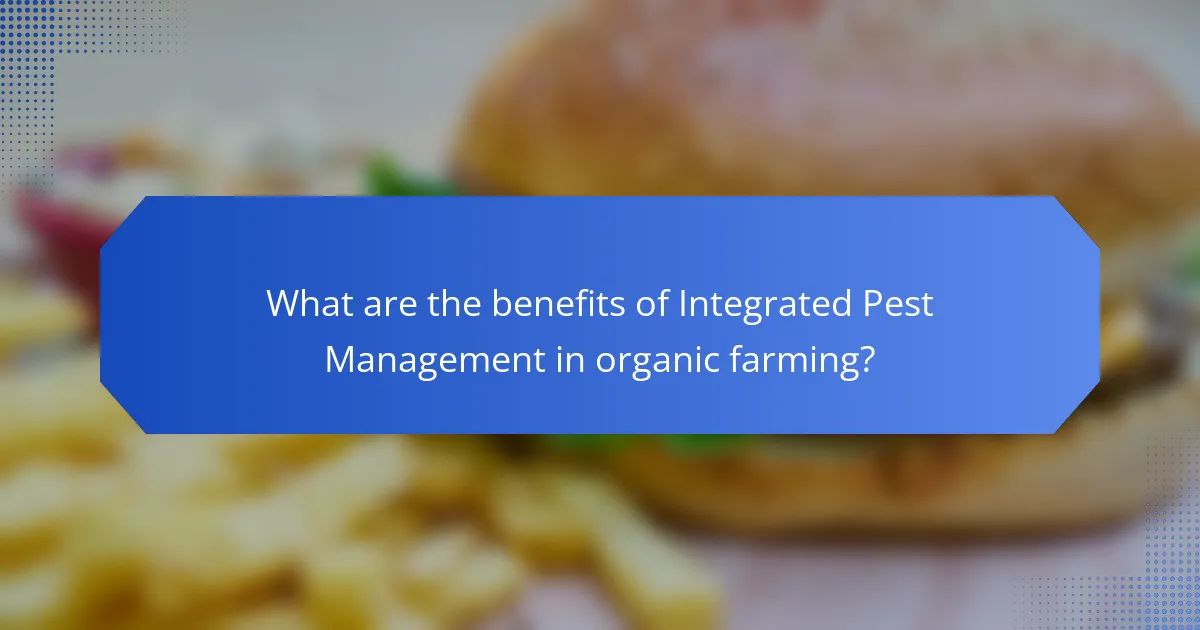
What are the benefits of Integrated Pest Management in organic farming?
Integrated Pest Management (IPM) in organic farming offers several key benefits. IPM reduces reliance on chemical pesticides. This leads to healthier crops and safer food for consumers. It promotes biodiversity by encouraging beneficial insects and natural predators. IPM practices can enhance soil health through reduced chemical runoff. This method often results in lower pest resistance over time. Additionally, IPM can improve economic returns by minimizing pest damage and lowering input costs. Research indicates that farms using IPM can see increased yields compared to those relying solely on conventional methods. Overall, IPM fosters sustainable agricultural practices while maintaining productivity.
How does Integrated Pest Management enhance crop yield and quality?
Integrated Pest Management (IPM) enhances crop yield and quality by reducing pest populations in a sustainable manner. IPM employs a combination of biological, cultural, physical, and chemical tools to manage pests. This multi-faceted approach minimizes crop damage caused by pests. Research shows that IPM can lead to yield increases of 10-30% in various crops. Additionally, healthier crops result from reduced pesticide use, improving overall quality. Studies indicate that IPM practices can enhance beneficial insect populations, which contribute to pest control and pollination. By maintaining ecological balance, IPM supports long-term agricultural sustainability.
What impact does Integrated Pest Management have on pest resistance?
Integrated Pest Management (IPM) reduces pest resistance by promoting diverse control strategies. IPM integrates biological, cultural, physical, and chemical methods to manage pest populations. This diversity disrupts the life cycles of pests and reduces the selection pressure for resistance. Research indicates that IPM can lead to lower pesticide use, which decreases the chances of pests developing resistance. A study published in the Journal of Economic Entomology found that fields using IPM had significantly lower pest resistance compared to conventional methods. By employing a holistic approach, IPM enhances long-term pest management effectiveness and sustainability.
How does Integrated Pest Management support ecosystem health?
Integrated Pest Management (IPM) supports ecosystem health by promoting biodiversity and reducing chemical pesticide use. IPM strategies enhance natural pest control mechanisms through the conservation of beneficial organisms. These organisms include predators and parasitoids that help manage pest populations naturally. Additionally, IPM practices improve soil health and water quality by minimizing chemical runoff. Research shows that farms utilizing IPM report higher levels of biodiversity compared to conventional farms. This increased biodiversity contributes to ecosystem resilience and stability. Overall, IPM fosters a balanced ecosystem that supports various plant and animal life.
What economic advantages does Integrated Pest Management provide?
Integrated Pest Management (IPM) provides several economic advantages. It reduces the cost of pest control by minimizing the use of expensive chemical pesticides. IPM promotes the use of biological and cultural control methods, which are often more cost-effective. Farmers implementing IPM can experience increased crop yields due to healthier plants and reduced pest damage. Studies show that IPM can lead to savings of up to 50% in pest management costs. Additionally, IPM practices can enhance market access by meeting organic certification requirements. This access can lead to higher prices for produce. Overall, IPM supports sustainable farming while improving profitability.
How can Integrated Pest Management reduce input costs for farmers?
Integrated Pest Management (IPM) reduces input costs for farmers by promoting efficient pest control strategies. IPM minimizes reliance on chemical pesticides, which can be expensive. By utilizing biological controls, farmers can lower their pesticide expenses significantly. Research indicates that farmers practicing IPM can reduce pesticide costs by up to 50%. Additionally, IPM encourages crop rotation and diversification, which can enhance soil health and reduce the need for fertilizers. Studies show that these practices lead to increased crop yields, further offsetting costs. Overall, IPM provides a sustainable approach that lowers input costs while maintaining productivity.
What are the long-term financial benefits of adopting Integrated Pest Management?
Adopting Integrated Pest Management (IPM) leads to significant long-term financial benefits. IPM reduces the need for chemical pesticides, resulting in lower input costs for farmers. According to a study by the National Academy of Sciences, IPM can decrease pest control costs by 30% to 50%. This method also enhances crop yields through improved pest management, leading to increased revenue. Furthermore, IPM practices promote sustainable farming, which can attract premium prices for organic produce. In addition, reduced pesticide use minimizes environmental cleanup costs and potential health-related expenses. Overall, IPM fosters a more resilient agricultural system that can adapt to changing market demands.
How does Integrated Pest Management align with organic farming principles?
Integrated Pest Management (IPM) aligns with organic farming principles by promoting sustainable agriculture practices. IPM emphasizes the use of natural pest control methods rather than synthetic chemicals. This approach supports biodiversity, a core principle of organic farming. IPM strategies include monitoring pest populations and using biological control agents, which are in line with organic standards. Research shows that IPM can reduce pest damage while maintaining environmental health. Studies indicate that farms using IPM report higher yields compared to those relying solely on chemical pesticides. Therefore, IPM complements organic farming by enhancing ecological balance and reducing chemical inputs.
What regulations support the use of Integrated Pest Management in organic farming?
The regulations that support the use of Integrated Pest Management (IPM) in organic farming are primarily outlined in the USDA National Organic Program (NOP) standards. These standards require organic farmers to implement IPM practices to manage pests sustainably. The regulations emphasize the use of natural and non-toxic methods before resorting to synthetic pesticides. Additionally, the Organic Foods Production Act mandates that organic farming must minimize the use of harmful substances and promote ecological balance. Compliance with these regulations ensures that organic farmers adopt IPM strategies effectively.
How does Integrated Pest Management contribute to sustainability in organic farming?
Integrated Pest Management (IPM) contributes to sustainability in organic farming by promoting ecological balance and reducing chemical inputs. IPM employs a combination of biological, cultural, and mechanical control methods. These methods minimize the reliance on synthetic pesticides. This approach enhances biodiversity and supports natural pest predators. IPM practices can lead to improved soil health and water conservation. Research indicates that farms using IPM techniques have lower pest populations and higher crop yields. A study published in the journal “Agriculture, Ecosystems & Environment” found that IPM can reduce pesticide use by up to 50% while maintaining productivity. This reduction supports long-term agricultural sustainability and environmental health.
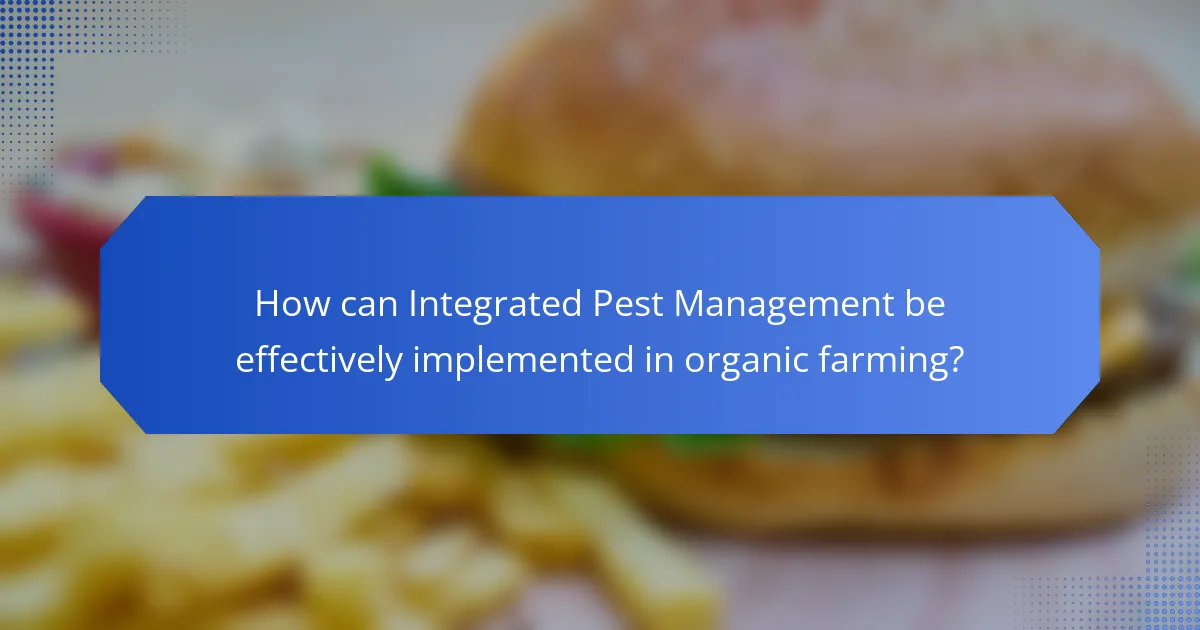
How can Integrated Pest Management be effectively implemented in organic farming?
Integrated Pest Management (IPM) can be effectively implemented in organic farming by integrating multiple strategies. These strategies include monitoring pest populations, using biological control agents, and employing cultural practices. Monitoring involves regular inspections to identify pest levels and their natural enemies. Biological control utilizes beneficial insects or microorganisms to suppress pest populations. Cultural practices may include crop rotation and selecting pest-resistant plant varieties.
Additionally, farmers can apply organic-approved pesticides as a last resort. Research shows that IPM can reduce pesticide use by 50% while maintaining crop yields. According to the USDA, IPM practices enhance biodiversity and promote sustainable agriculture. Implementing IPM in organic farming leads to healthier ecosystems and improved crop resilience.
What steps are involved in developing an Integrated Pest Management plan?
The steps involved in developing an Integrated Pest Management (IPM) plan include assessing the pest situation, setting action thresholds, implementing control measures, and evaluating the effectiveness of the plan. First, assessing the pest situation involves identifying the pests and understanding their biology and ecology. This step is crucial for determining the appropriate management strategies. Second, setting action thresholds helps to decide when pest populations require control measures. This prevents unnecessary interventions. Third, implementing control measures involves using a combination of biological, cultural, mechanical, and chemical methods tailored to the specific pest problem. Finally, evaluating the effectiveness of the plan ensures that the IPM strategies are successful and allows for adjustments as needed. These steps are essential for creating a sustainable and effective IPM plan.
How do farmers assess pest populations and make management decisions?
Farmers assess pest populations through various monitoring techniques. They utilize traps, visual inspections, and scouting methods. Traps can include sticky traps or pheromone traps to capture specific pests. Visual inspections involve checking plants for signs of damage or pest presence. Scouting often occurs on a regular schedule to evaluate pest levels.
Farmers make management decisions based on established action thresholds. Action thresholds indicate when pest populations reach levels that may cause economic harm. Integrated Pest Management (IPM) strategies guide these decisions. IPM combines biological, cultural, and chemical control methods.
Farmers also consider environmental conditions and pest life cycles. This information helps in timing interventions effectively. Data from previous seasons may inform current management practices. By integrating these assessments, farmers can implement targeted and sustainable pest control measures.
What tools and resources are available for implementing Integrated Pest Management?
Tools and resources for implementing Integrated Pest Management (IPM) include various strategies and materials. These tools encompass monitoring devices, such as traps and pheromones, to assess pest populations. Biological control agents, like beneficial insects, are also essential for managing pests naturally. Cultural practices, including crop rotation and habitat manipulation, help reduce pest establishment. Additionally, educational resources, such as extension programs and IPM training workshops, provide guidance on best practices. Research publications and online databases, like the USDA’s National Agricultural Library, offer valuable information on IPM methodologies. These resources collectively support effective pest management in organic farming.
What challenges might farmers face when implementing Integrated Pest Management?
Farmers may face several challenges when implementing Integrated Pest Management (IPM). One significant challenge is the need for knowledge and training. Farmers must understand various pest life cycles and ecological interactions. This requires ongoing education and resources. Additionally, farmers may encounter resistance from pests. Some pests can develop resistance to the methods used in IPM, making management more difficult.
Cost is another challenge. Implementing IPM can require initial investments in technology and practices. This may be a barrier for some farmers. Time constraints can also be an issue. Farmers often have limited time to monitor pest populations and apply IPM strategies effectively.
Furthermore, access to resources can vary. Not all farmers have equal access to the necessary tools and information. Lastly, market demand may influence the adoption of IPM. Consumers may not always prioritize sustainably grown produce, impacting farmers’ willingness to adopt these practices.
How can farmers overcome barriers to adopting Integrated Pest Management practices?
Farmers can overcome barriers to adopting Integrated Pest Management (IPM) practices by increasing education and training on IPM techniques. Access to resources and information is crucial for understanding IPM benefits. Collaboration with agricultural extension services can provide tailored support. Financial incentives can help offset initial costs associated with implementing IPM. Networking with other farmers who successfully use IPM can share practical insights. Additionally, demonstrating the long-term cost savings of IPM can encourage adoption. Research shows that farms using IPM can reduce pesticide costs by up to 30%.
What common mistakes should be avoided in Integrated Pest Management implementation?
Common mistakes in Integrated Pest Management (IPM) implementation include inadequate pest identification. Accurate identification is crucial for effective management strategies. Failing to monitor pest populations can lead to ineffective treatments. Regular monitoring ensures timely interventions and reduces reliance on pesticides. Overlooking beneficial insects is another mistake. These insects can naturally control pest populations. Ignoring the importance of cultural practices can also hinder success. Practices like crop rotation and sanitation are essential in IPM. Relying solely on chemical controls is a significant error. IPM emphasizes a holistic approach, combining multiple strategies. Lastly, neglecting to educate stakeholders can lead to miscommunication and ineffective practices. Training and awareness are vital for successful IPM implementation.
What best practices should be followed for successful Integrated Pest Management?
Successful Integrated Pest Management (IPM) requires a combination of practices. First, monitoring pest populations is essential. Regularly inspect crops to identify pest types and levels. Second, use cultural practices to minimize pest establishment. Crop rotation and selecting resistant varieties can disrupt pest life cycles. Third, implement biological control methods. Introducing natural predators can help manage pest populations effectively. Fourth, apply chemical controls judiciously. Use pesticides only when necessary and select targeted options to reduce harm to beneficial organisms. Fifth, educate and train all personnel involved in pest management. Knowledge about pest identification and management techniques improves overall effectiveness. These practices align with IPM principles, promoting sustainable agriculture while minimizing environmental impact.
How can continuous education and training improve Integrated Pest Management outcomes?
Continuous education and training enhance Integrated Pest Management (IPM) outcomes by improving knowledge and skills among practitioners. This leads to more effective pest identification and management strategies. Educated individuals can better understand pest life cycles and behaviors. They are also more adept at utilizing sustainable practices. Training programs often include the latest research and technological advancements. This ensures that practitioners apply the most effective methods available. Studies show that trained individuals achieve higher crop yields and reduced pest damage. For example, a study by the University of California found that IPM training increased the adoption of environmentally friendly pest control methods. This resulted in a 30% reduction in pesticide use among participants. Thus, continuous education and training are crucial for optimizing IPM practices.
What role does community involvement play in successful Integrated Pest Management?
Community involvement is essential for successful Integrated Pest Management (IPM). It fosters collaboration among stakeholders, including farmers, local organizations, and residents. Engaging the community enhances knowledge sharing about pest identification and management practices. It encourages participation in monitoring pest populations and implementing control measures. Studies show that community-led initiatives can improve pest management outcomes. For example, a research project in California demonstrated that local engagement increased the adoption of sustainable practices. This involvement also builds trust and ensures that IPM strategies are culturally relevant. Overall, community participation strengthens the effectiveness of IPM programs.
Integrated Pest Management (IPM) is a sustainable approach to controlling pest populations in agriculture, emphasizing the integration of biological, cultural, physical, and chemical strategies. This article explores the principles, components, and benefits of IPM, particularly in organic farming, highlighting its role in reducing pesticide use, enhancing crop yields, and supporting ecosystem health. Key topics include the importance of monitoring pest populations, the use of biological control agents, and the economic advantages of adopting IPM practices. Additionally, the article addresses the challenges farmers may face in implementing IPM and offers best practices for successful adoption.
